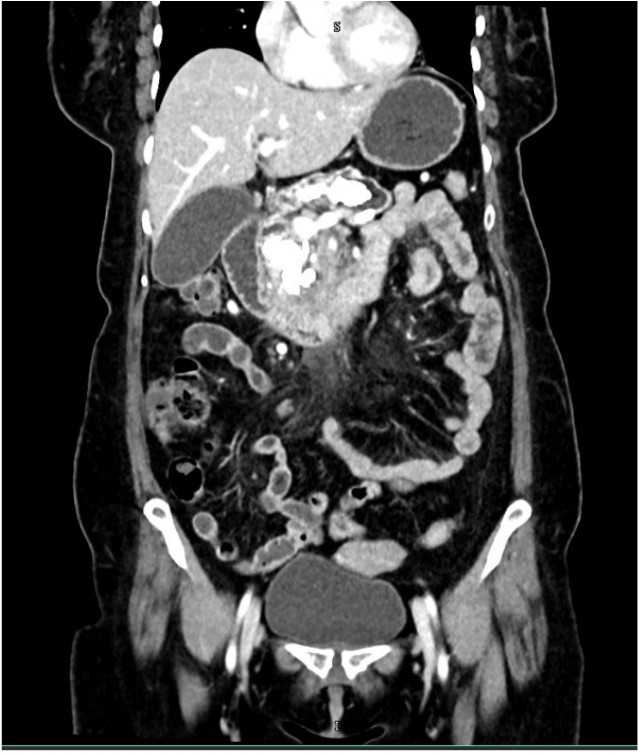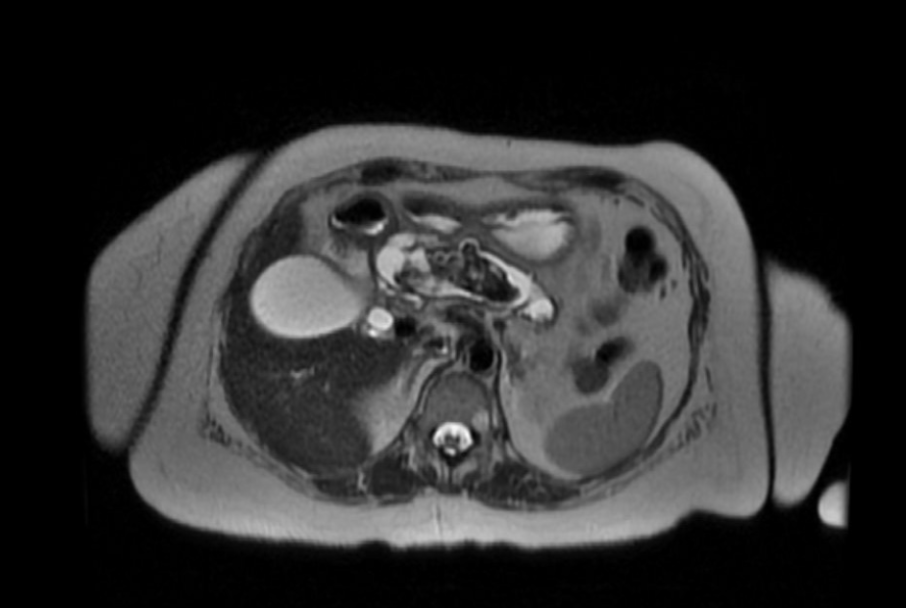Tuesday Poster Session
Category: Biliary/Pancreas
P4520 - Giant Pancreatolithiasis
Tuesday, October 28, 2025
10:30 AM - 4:00 PM PDT
Location: Exhibit Hall

Mehak Sharma, MD
Florida International University
Miami, FL
Presenting Author(s)
Mehak Sharma, MD1, Tanisha Kalra, MD2, Sushil K. Ahlawat, MD2
1Florida International University, Miami, FL; 2SUNY Downstate Medical Center, Brooklyn, NY
Introduction: Chronic pancreatitis is a progressive inflammatory disease, contributing to loss of pancreatic function. In Western society, this is most commonly due to alcohol abuse in 70% of reported cases. Patients with chronic pancreatitis without an identifiable etiology are classified as idiopathic chronic pancreatitis (ICP). One type of ICP is tropical pancreatitis (also known as chronic calcific pancreatitis) seen in tropical developing countries, including Bangladesh. The etiology of this condition is multifactorial, due to environmental and genetic factors. Studies from Bangladesh and South India describe a type of tropical pancreatitis characterized by a young age of onset, large intraductal calculi, and pancreatic decline. However, in North India exists an ICP subtype, where patients are diagnosed in the third decade with pain as a primary symptom.
Case Description/
Methods: A 47 year old female with type 2 diabetes mellitus (diagnosed 2019) and hypertension presented to a University Hospital with a two month history of sharp abdominal pain. She also reported unintentional weight loss of 42 pounds. Labs revealed IgG 4 150.5 mg/dL, triglycerides 140 mg/dL, liver enzymes peaking 4 days after admission, AST 710 U/L, 407 138 U/L, CA 19-9 443 U/mL. A Computed tomography of the abdomen and pelvis with contrast showed an ill-defined mass in the pancreatic head and uncinate process with fat tissue stranding, measuring 3.8 x 4.6 x 4.7 cm and pancreatic ductal dilatation with multiple large intraductal calcifications. Magnetic resonance cholangiopancreatography revealed an atrophic pancreas with pancreatic duct dilatation, large filling defects consistent with stones, the largest 5 x 2 cm in the main pancreatic duct. She is a lifelong non-smoker and never consumed alcohol.
Discussion: Tropical pancreatitis is identified by young age of onset, large intraductal calculi, and diabetes. An ICP variant is seen near 33 years of age with normal body index. 96% of cases reported abdominal pain as one of the presenting clinical features. This varies from patients with tropical pancreatitis in Bangladesh, where there is a link with malnourishment and absence of abdominal pain as the primary complaint. This is a rare case of chronic idiopathic pancreatitis mimicking tropical pancreatitis. Interestingly, the patient of Bangladeshi origin presents as North Indian ICP while living in the United States.

Figure: CT Abdomen and Pelvis with IV contrast: Ill-defined masslike soft tissue in the region of the pancreatic head and uncinate process. There is subtle adjacent fat tissue stranding. The soft tissue component occupies a space
roughly measuring 3.8 x 4.6 x 4.7 cm. There is pancreatic ductal dilatation with multiple large intraductal calcifications.

Figure: MRI Abdomen and Pelvis
The pancreas is atrophic. There is marked pancreatic duct dilatation with large filling defects consistent with stones. The largest stone measures roughly
5 x 2 cm in the main pancreatic duct. Smaller stones are seen in the proximal
pancreatic duct near the ampulla.
Disclosures:
Mehak Sharma indicated no relevant financial relationships.
Tanisha Kalra indicated no relevant financial relationships.
Sushil Ahlawat indicated no relevant financial relationships.
Mehak Sharma, MD1, Tanisha Kalra, MD2, Sushil K. Ahlawat, MD2. P4520 - Giant Pancreatolithiasis, ACG 2025 Annual Scientific Meeting Abstracts. Phoenix, AZ: American College of Gastroenterology.
1Florida International University, Miami, FL; 2SUNY Downstate Medical Center, Brooklyn, NY
Introduction: Chronic pancreatitis is a progressive inflammatory disease, contributing to loss of pancreatic function. In Western society, this is most commonly due to alcohol abuse in 70% of reported cases. Patients with chronic pancreatitis without an identifiable etiology are classified as idiopathic chronic pancreatitis (ICP). One type of ICP is tropical pancreatitis (also known as chronic calcific pancreatitis) seen in tropical developing countries, including Bangladesh. The etiology of this condition is multifactorial, due to environmental and genetic factors. Studies from Bangladesh and South India describe a type of tropical pancreatitis characterized by a young age of onset, large intraductal calculi, and pancreatic decline. However, in North India exists an ICP subtype, where patients are diagnosed in the third decade with pain as a primary symptom.
Case Description/
Methods: A 47 year old female with type 2 diabetes mellitus (diagnosed 2019) and hypertension presented to a University Hospital with a two month history of sharp abdominal pain. She also reported unintentional weight loss of 42 pounds. Labs revealed IgG 4 150.5 mg/dL, triglycerides 140 mg/dL, liver enzymes peaking 4 days after admission, AST 710 U/L, 407 138 U/L, CA 19-9 443 U/mL. A Computed tomography of the abdomen and pelvis with contrast showed an ill-defined mass in the pancreatic head and uncinate process with fat tissue stranding, measuring 3.8 x 4.6 x 4.7 cm and pancreatic ductal dilatation with multiple large intraductal calcifications. Magnetic resonance cholangiopancreatography revealed an atrophic pancreas with pancreatic duct dilatation, large filling defects consistent with stones, the largest 5 x 2 cm in the main pancreatic duct. She is a lifelong non-smoker and never consumed alcohol.
Discussion: Tropical pancreatitis is identified by young age of onset, large intraductal calculi, and diabetes. An ICP variant is seen near 33 years of age with normal body index. 96% of cases reported abdominal pain as one of the presenting clinical features. This varies from patients with tropical pancreatitis in Bangladesh, where there is a link with malnourishment and absence of abdominal pain as the primary complaint. This is a rare case of chronic idiopathic pancreatitis mimicking tropical pancreatitis. Interestingly, the patient of Bangladeshi origin presents as North Indian ICP while living in the United States.

Figure: CT Abdomen and Pelvis with IV contrast: Ill-defined masslike soft tissue in the region of the pancreatic head and uncinate process. There is subtle adjacent fat tissue stranding. The soft tissue component occupies a space
roughly measuring 3.8 x 4.6 x 4.7 cm. There is pancreatic ductal dilatation with multiple large intraductal calcifications.

Figure: MRI Abdomen and Pelvis
The pancreas is atrophic. There is marked pancreatic duct dilatation with large filling defects consistent with stones. The largest stone measures roughly
5 x 2 cm in the main pancreatic duct. Smaller stones are seen in the proximal
pancreatic duct near the ampulla.
Disclosures:
Mehak Sharma indicated no relevant financial relationships.
Tanisha Kalra indicated no relevant financial relationships.
Sushil Ahlawat indicated no relevant financial relationships.
Mehak Sharma, MD1, Tanisha Kalra, MD2, Sushil K. Ahlawat, MD2. P4520 - Giant Pancreatolithiasis, ACG 2025 Annual Scientific Meeting Abstracts. Phoenix, AZ: American College of Gastroenterology.
